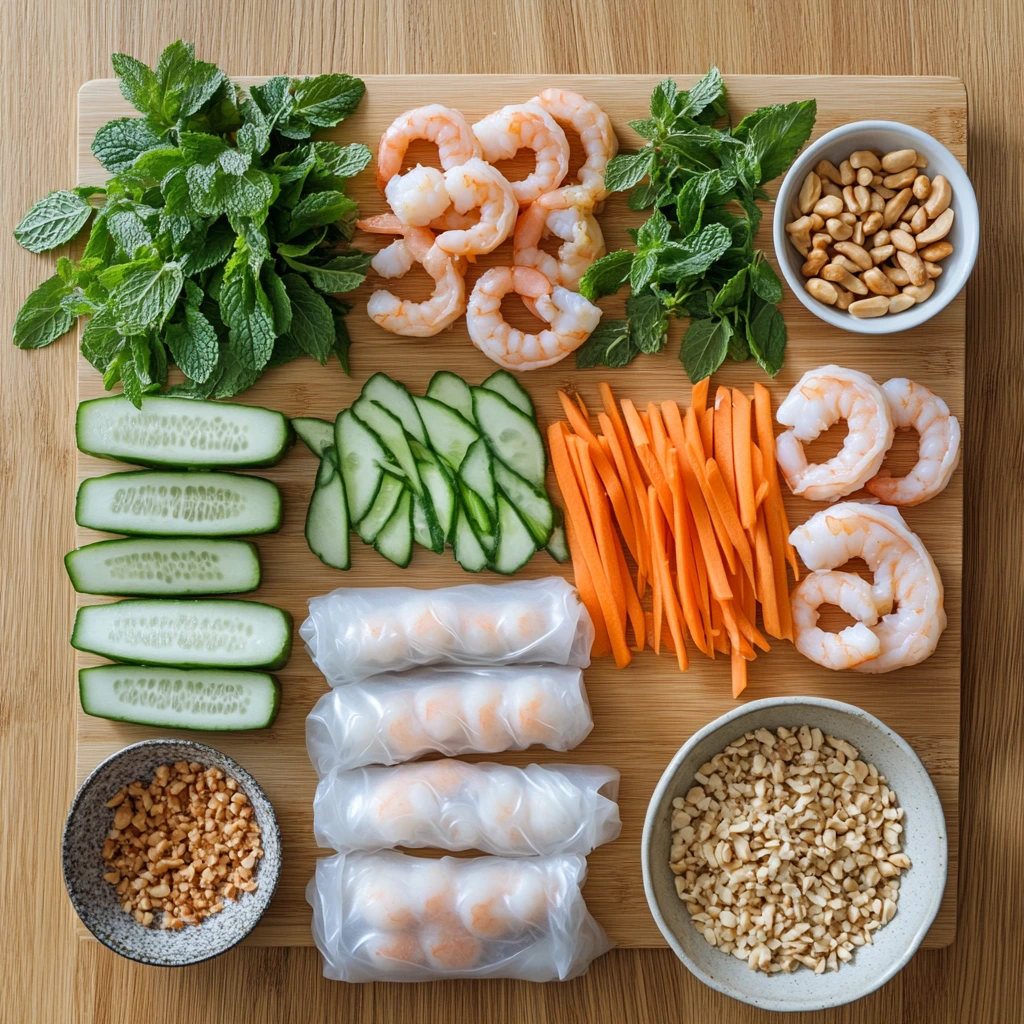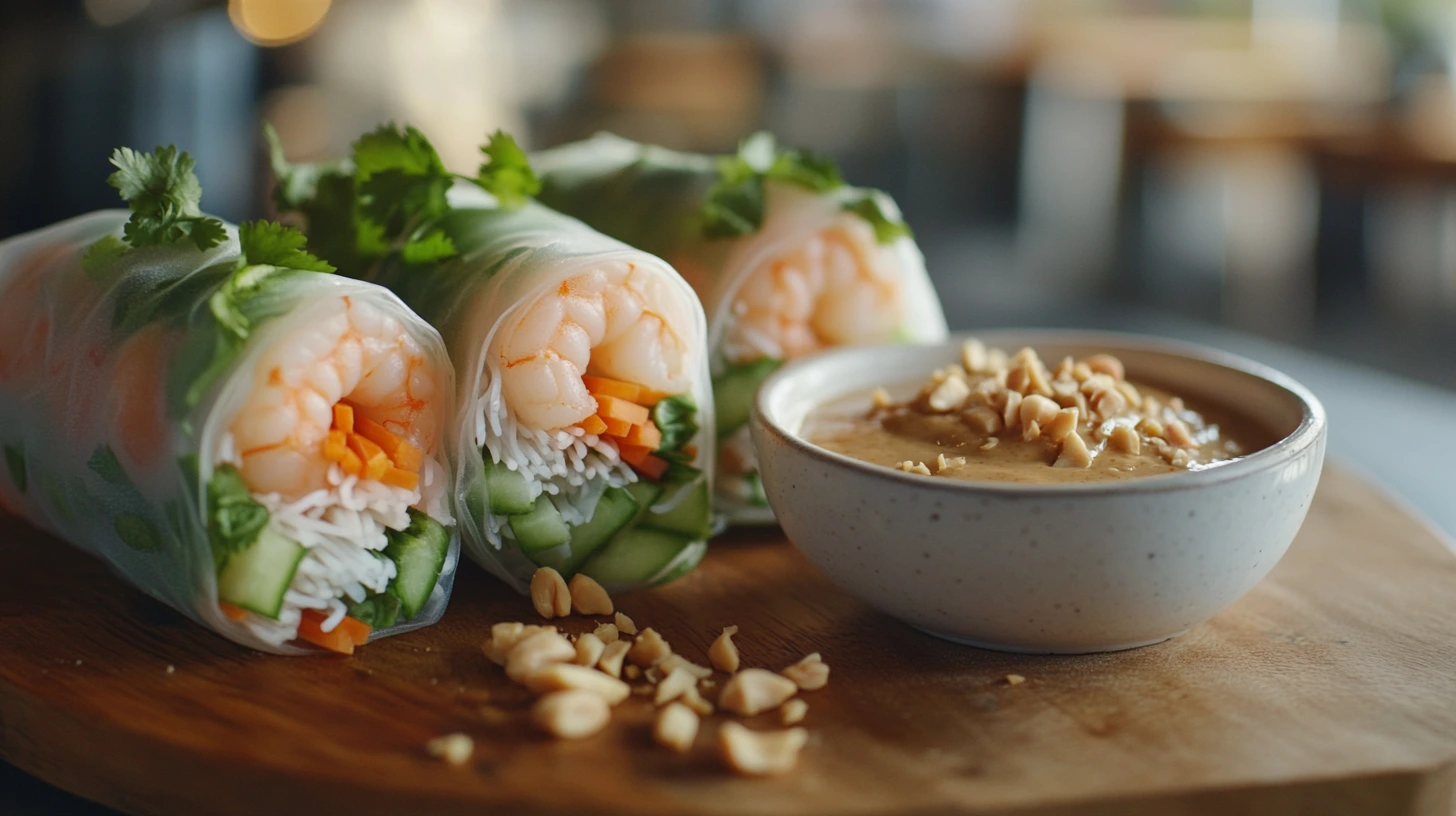When you think of light, fresh, and flavorful dishes, shrimp spring rolls undoubtedly make the list. These Vietnamese-inspired delights are as much a feast for the eyes as they are for the taste buds. Bursting with the crunch of fresh vegetables, the tenderness of shrimp, and the unique chewiness of rice paper wrappers, shrimp spring rolls are versatile enough to serve as appetizers, light meals, or snacks.
In this comprehensive guide, we’ll walk you through everything you need to know to make shrimp spring rolls that are both delicious and easy to prepare. From ingredient selection to step-by-step instructions, tips, and FAQs, this guide ensures your spring rolls turn out perfect every time. Let’s dive in!
Table of Contents
Why Shrimp Spring Rolls Are a Crowd Favorite
its aren’t just about taste; they’re a perfect balance of nutrition, texture, and convenience. Here’s why they should be on your menu:
1. Health Benefits
- High in Protein: Shrimp provides a lean source of protein to keep you energized and satiated.
- Rich in Vitamins: Fresh vegetables like carrots and lettuce are packed with essential nutrients.
- Low-Calorie Option: With no frying involved, shrimp spring rolls are a lighter alternative to traditional fried snacks.
2. Quick and Easy
With a bit of prep, you can assemble these rolls in no time. They’re ideal for busy weeknights, gatherings, or when you want a healthy meal without much fuss.
3. Visually Stunning
The vibrant colors of the shrimp, herbs, and vegetables wrapped in translucent rice paper create an Instagram-worthy dish that’s sure to impress your guests.
Ingredients for Shrimp Spring Rolls
Before you begin, gather the ingredients listed below. The key to great spring rolls is using fresh, high-quality components.
| Ingredient | Quantity | Notes |
|---|---|---|
| Rice paper wrappers | 10 sheets | Essential for wrapping |
| Cooked shrimp | 20 pieces | Deveined, peeled, and halved |
| Rice vermicelli noodles | 100g | Adds texture |
| Lettuce leaves | 10 large leaves | Romaine or butter lettuce works |
| Fresh herbs (mint, basil) | 1/2 cup each | Adds authenticity and flavor |
| Carrots (julienned) | 1 cup | Crunch and sweetness |
| Cucumber (julienned) | 1 cup | Refreshing and crisp |
| Peanut sauce | 1/2 cup | Optional but recommended |
| Optional add-ons | Mango, avocado | For variety |

Step-by-Step Guide to Making Shrimp Spring Rolls
1: Prep Your Ingredients
- Cook the Noodles: Boil rice vermicelli according to package instructions. Rinse under cold water and set aside.
- Prepare the Vegetables: Wash and julienne carrots and cucumbers. Tear lettuce leaves into manageable sizes.
- Slice the Shrimp: Halve each shrimp lengthwise for better distribution and texture.
- Wash the Herbs: Rinse fresh mint and basil thoroughly, then pat them dry.
2: Soften the Rice Paper Wrappers
- Fill a large shallow bowl or plate with warm water.
- Submerge one rice paper wrapper at a time, soaking it for 5–10 seconds until soft but not overly soggy.
- Carefully lay the softened wrapper on a clean, flat surface.
3: Assemble the Rolls
- Place a lettuce leaf on the lower third of the wrapper.
- Add a small handful of noodles, followed by julienned carrots, cucumbers, and herbs.
- Lay two shrimp halves on top for visibility through the wrapper.
- Fold the sides inward, then roll tightly from the bottom up, ensuring all ingredients are secure.
4: Serve and Enjoy
Arrange the rolls on a platter and serve with your choice of dipping sauce, such as peanut sauce or hoisin sauce.
Tips for Perfect Shrimp Spring Rolls
Making shrimp spring rolls is easy, but these tips will help you take them to the next level:
- Use Fresh Ingredients: Fresh vegetables and herbs make all the difference in flavor and texture.
- Work Quickly: Rice paper wrappers can dry out if left too long after softening.
- Don’t Overstuff: Overloading your rolls can cause the wrappers to tear.
- Serve Immediately: While you can store them for a short time, are best enjoyed fresh.
Creative Variations to Try
Shrimp spring rolls are incredibly versatile. Here are a few ways to customize them:
- Vegetarian Spring Rolls: Swap shrimp for tofu or mushrooms.
- Tropical Twist: Add slices of mango or pineapple for a sweet and tangy flavor.
- Spicy Rolls: Include sliced jalapeños or a drizzle of sriracha for a kick.
Are Vietnamese Shrimp Spring Rolls Healthy?
Yes, Vietnamese shrimp spring rolls are a fantastic choice for a healthy meal or snack. Here’s why:
- Low in Calories: Unlike fried spring rolls, these are not cooked in oil, keeping them light and low in fat.
- Nutrient-Rich Ingredients: They are packed with fresh vegetables, providing a variety of vitamins, minerals, and antioxidants.
- High in Protein: Shrimp is a lean source of protein, which helps in muscle repair and keeps you feeling full longer.
- Naturally Gluten-Free: With rice paper and rice noodles, these rolls are suitable for those avoiding gluten.
- Customizable for Diets: You can easily adjust the fillings to match specific dietary needs, such as adding avocado for healthy fats or using tofu for a vegetarian option.
These qualities make shrimp spring rolls not just delicious but also a guilt-free indulgence you can enjoy any time.
What’s the Difference Between Chinese Egg Rolls and Spring Rolls?
While both egg rolls and spring rolls are popular dishes, they differ significantly in preparation, ingredients, and presentation:
- Wrapper:
- Egg rolls are made with a thicker, wheat-based wrapper that becomes crispy when fried.
- Spring rolls use a thinner rice paper wrapper, which can be served fresh or lightly fried.
- Filling:
- Egg rolls often include cooked ingredients like cabbage, pork, or shrimp mixed with seasonings.
- Spring rolls emphasize fresh, raw ingredients such as shrimp, lettuce, herbs, and vermicelli noodles.
- Cooking Method:
- Egg rolls are typically deep-fried, resulting in a golden, crispy exterior.
- Spring rolls can be served fresh (as in Vietnamese shrimp spring rolls) or fried, depending on the recipe.
- Cultural Origins:
- Egg rolls are a staple in Chinese-American cuisine.
- Spring rolls have roots in Vietnamese and other Southeast Asian cuisines.
Understanding these differences helps you appreciate the unique flavors and textures each dish offers.
What’s the Difference Between Spring Rolls and Thai Spring Rolls?
Spring rolls and Thai spring rolls are similar but distinct in several ways:
- Flavor Profile:
- Thai spring rolls often incorporate bold flavors like garlic, cilantro, and fish sauce.
- Vietnamese spring rolls focus on fresh, mild ingredients like shrimp, herbs, and vegetables.
- Wrapper Type:
- Thai spring rolls may use a slightly thicker wrapper, especially for fried versions.
- Vietnamese spring rolls are typically made with delicate rice paper.
- Cooking Style:
- Thai spring rolls are commonly fried, giving them a crunchy texture.
- Vietnamese spring rolls are usually served fresh, maintaining their light and healthy appeal.
- Dipping Sauces:
- Thai spring rolls are often paired with sweet chili sauce.
- Vietnamese spring rolls are typically served with peanut sauce or nuoc cham (a fish sauce-based dip).
These differences reflect the unique culinary traditions of each cuisine, offering a variety of ways to enjoy this versatile dish.
How to Eat Shrimp Spring Rolls
Eating shrimp spring rolls is as enjoyable as making them. Here are a few tips to enhance your experience:
- Pair with Sauce: Always match your rolls with a flavorful dipping sauce like peanut, hoisin, or sweet chili sauce. Dip generously to enjoy the full flavor.
- Pairing Options: Complement your meal with sides like pickled vegetables or a light salad to create a balanced dish..
- Pairing Options: Serve with a side of pickled vegetables or a light salad for a complete meal.
- Utensils or Hands: While it’s perfectly fine to use your hands, you can also use chopsticks to keep the experience authentic.
Frequently Asked Questions
Can I Make Shrimp Spring Rolls Ahead of Time?
Yes, but keep in mind that rice paper wrappers can dry out or become sticky. To prevent this, wrap each roll in a damp paper towel and store them in an airtight container.
What’s the Best Dipping Sauce for Shrimp Spring Rolls?
Peanut sauce, hoisin sauce, and sweet chili sauce are all excellent options. For a lighter alternative, try a lime and fish sauce dip.
Are Shrimp Spring Rolls Gluten-Free?
Most rice paper wrappers and noodles are gluten-free, but always check the labels on sauces and additional ingredients.
How Do I Keep the Rolls from Sticking Together?
Place a sheet of parchment paper or lightly oil the surface between each roll to prevent sticking.
Call to Action: Create Your Own Shrimp Spring Rolls Today!
Now that you know the ins and outs of making shrimp spring rolls, it’s time to bring this recipe to life. Whether you’re looking for a healthy snack, a show-stopping appetizer, or a light meal, shrimp spring rolls have something for everyone.
So grab your ingredients, follow the steps, and enjoy the satisfaction of creating a dish that’s as delicious as it is beautiful. Share your creations on social media and tag your friends for a fun spring roll night. Don’t forget to bookmark this guide for future use and explore even more variations to make these rolls your own.
Happy rolling!

